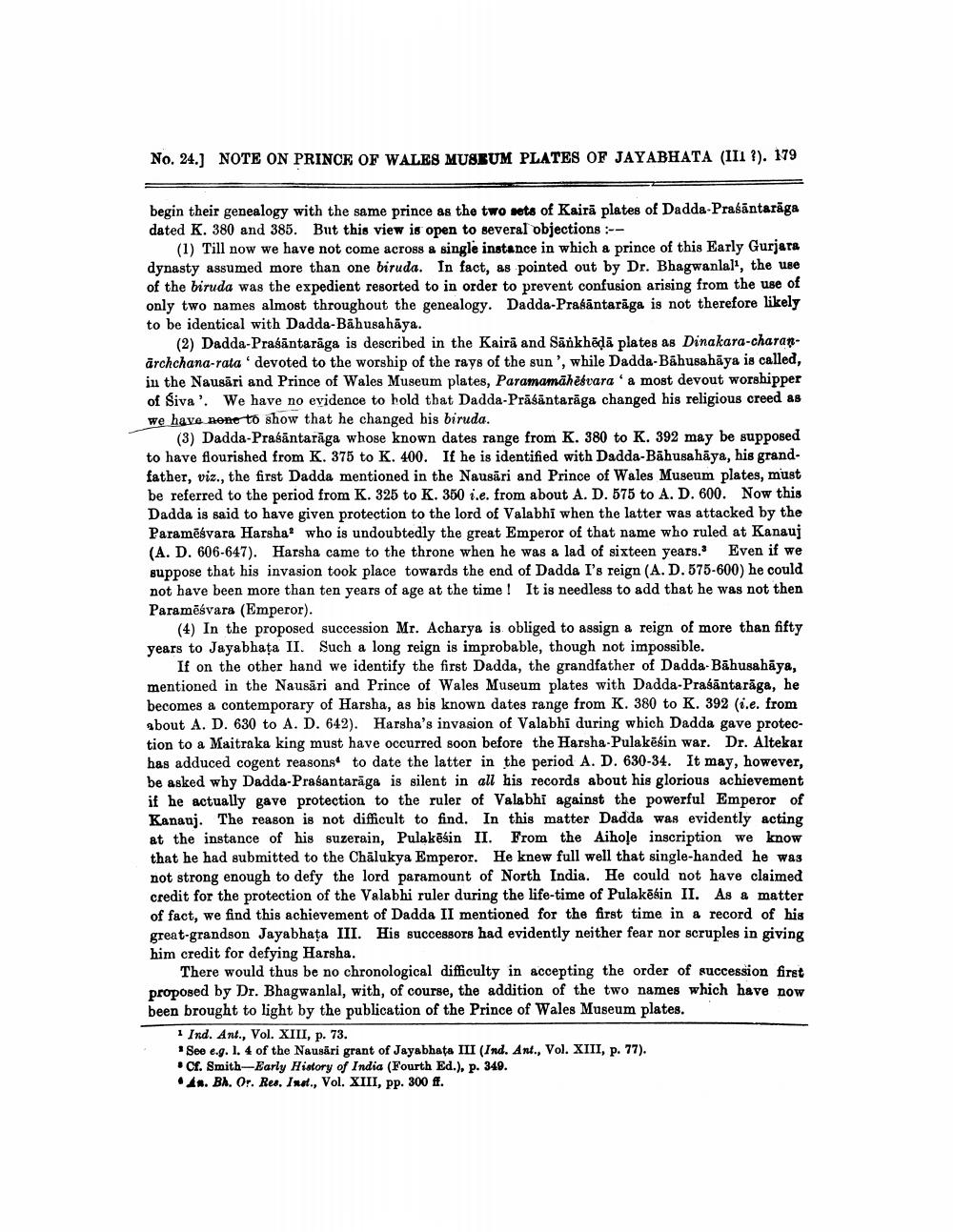________________
No. 24.] NOTE ON PRINCE OF WALES MUSEUM PLATES OF JAYABHATA (II1 ?). 179
begin their genealogy with the same prince as the two sets of Kaira plates of Dadda-Praśāntarāga dated K. 380 and 385. But this view is open to several objections :--
(1) Till now we have not come across a single instance in which a prince of this Early Gurjara dynasty assumed more than one biruda. In fact, as pointed out by Dr. Bhagwanlal1, the use of the biruda was the expedient resorted to in order to prevent confusion arising from the use of only two names almost throughout the genealogy. Dadda-Praśāntarāga is not therefore likely to be identical with Dadda-Bahusahāya.
(2) Dadda-Praśāntarāga is described in the Kaira and Sankhēḍā plates as Dinakara-charanarchchana-rata devoted to the worship of the rays of the sun', while Dadda-Bahusahaya is called, in the Nausari and Prince of Wales Museum plates, Paramamāhesvara a most devout worshipper of Siva'. We have no evidence to hold that Dadda-Prasantaraga changed his religious creed as we have none to show that he changed his biruda.
(3) Dadda-Praśāntarāga whose known dates range from K. 380 to K. 392 may be supposed to have flourished from K. 375 to K. 400. If he is identified with Dadda-Bahusahāya, his grandfather, viz., the first Dadda mentioned in the Nausari and Prince of Wales Museum plates, must be referred to the period from K. 325 to K. 350 i.e. from about A. D. 575 to A. D. 600. Now this Dadda is said to have given protection to the lord of Valabhi when the latter was attacked by the Paramesvara Harsha who is undoubtedly the great Emperor of that name who ruled at Kanauj (A. D. 606-647). Harsha came to the throne when he was a lad of sixteen years. Even if we suppose that his invasion took place towards the end of Dadda I's reign (A. D. 575-600) he could not have been more than ten years of age at the time! It is needless to add that he was not then Paramesvara (Emperor).
(4) In the proposed succession Mr. Acharya is obliged to assign a reign of more than fifty years to Jayabhața II. Such a long reign is improbable, though not impossible.
If on the other hand we identify the first Dadda, the grandfather of Dadda-Bāhusahāya, mentioned in the Nausari and Prince of Wales Museum plates with Dadda-Praśāntarāga, he becomes a contemporary of Harsha, as his known dates range from K. 380 to K. 392 (i.e. from about A. D. 630 to A. D. 642). Harsha's invasion of Valabhi during which Dadda gave protection to a Maitraka king must have occurred soon before the Harsha-Pulakesin war. Dr. Altekar has adduced cogent reasons to date the latter in the period A. D. 630-34. It may, however, be asked why Dadda-Prasantaraga is silent in all his records about his glorious achievement if he actually gave protection to the ruler of Valabhi against the powerful Emperor of Kanauj. The reason is not difficult to find. In this matter Dadda was evidently acting at the instance of his suzerain, Pulakesin II. From the Aihole inscription we know that he had submitted to the Chalukya Emperor. He knew full well that single-handed he was not strong enough to defy the lord paramount of North India. He could not have claimed credit for the protection of the Valabhi ruler during the life-time of Pulakesin II. As a matter of fact, we find this achievement of Dadda II mentioned for the first time in a record of his great-grandson Jayabhata III. His successors had evidently neither fear nor scruples in giving him credit for defying Harsha.
There would thus be no chronological difficulty in accepting the order of succession first proposed by Dr. Bhagwanlal, with, of course, the addition of the two names which have now been brought to light by the publication of the Prince of Wales Museum plates.
1 Ind. Ant., Vol. XIII, p. 73.
* See e.g. 1. 4 of the Nausari grant of Jayabhata III (Ind. Ant., Vol. XIII, p. 77).
Cf. Smith-Early History of India (Fourth Ed.), p. 349. An. Bh. Or. Res. Inst., Vol. XIII, pp. 300 ff.




